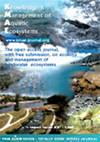Population dynamics and feeding ecology of the invasive Caucasian dwarf goby, Knipowitschia caucasica, in a freshwater habitat in Ukraine
IF 1.7
3区 环境科学与生态学
Q3 FISHERIES
引用次数: 7
Abstract
Population dynamics and feeding patterns of invasive Knipowitschia caucasica were studied in the littoral zone of the lower Stugna River. The abundances of this goby showed significant inter-annual and seasonal fluctuations. The studied population of K. caucasica was represented by two age groups (0 and I). Fish die after their first breeding season. In total, 58 prey items were identified in the diet of K. caucasica at the sampling site. The most abundant prey were copepods and cladocerans, while the most frequently encountered prey were copepods and chironomid larvae. Copepods were represented mainly by Cyclopoidae. Cladocerans included 21 taxa, among which the most abundant were Diaphanosoma sp., Acroperus harpae, and Disparalona rostrata; chironomids included 22 taxa, among which the most abundant was Cricotopus sylvestris. The diet composition showed seasonal dynamics, where copepods predominated in January to April and in August-September, chironomid larvae were especially important in May to July, while cladocerans were most important in November-December. The relatively high diversity of both phytophilous and open-bottom-dwelling prey organisms in the stomach contents of K. caucasica indicates that this species fed on a large variety of benthic habitats including among macrophytes and open areas.乌克兰淡水栖息地入侵高加索矮虾虎鱼的种群动态和摄食生态学
研究了斯图格纳河下游沿岸入侵性高加索刀刀蝗的种群动态和摄食模式。虾虎鱼的丰度呈明显的年际和季节波动。研究种群分为2个年龄组(0和1),鱼在第一个繁殖季节后死亡。在采样点的白桦尺蠖饮食中共鉴定出58种猎物。最丰富的猎物是桡足类和枝海类,最常见的猎物是桡足类和手形动物的幼虫。桡足类以环足科为主。进化纲包括21个类群,其中数量最多的是Diaphanosoma sp.、Acroperus harpae和Disparalona rostrata;chironomids包括22个分类群,其中数量最多的是Cricotopus sylvestris。饵料构成呈季节性变化,1 ~ 4月和8 ~ 9月以桡足类为主,5 ~ 7月以手蚓类幼虫为主,11 ~ 12月以枝纲幼虫为主。高加索白鼬胃内容物中植栖和开底栖猎物生物的多样性都相对较高,这表明该物种捕食的底栖生物种类繁多,包括大型植物和开阔区域。
本文章由计算机程序翻译,如有差异,请以英文原文为准。
求助全文
约1分钟内获得全文
求助全文
来源期刊

Knowledge and Management of Aquatic Ecosystems
环境科学-海洋与淡水生物学
CiteScore
3.70
自引率
5.60%
发文量
22
审稿时长
>12 weeks
期刊介绍:
Knowledge and Management of Aquatic Ecosystems (KMAE-Bulletin Français de la Pêche et de la Pisciculture since 1928) serves as a foundation for scientific advice across the broad spectrum of management and conservation issues related to freshwater ecosystems.
The journal publishes articles, short communications, reviews, comments and replies that contribute to a scientific understanding of freshwater ecosystems and the impact of human activities upon these systems. Its scope includes economic, social, and public administration studies, in so far as they are directly concerned with the management of freshwater ecosystems (e.g. European Water Framework Directive, USA Clean Water Act, Canadian Water Quality Guidelines, …) and prove of general interest to freshwater specialists. Papers on insular freshwater ecosystems and on transitional waters are welcome. KMAE is not a preferred journal for taxonomical, physiological, biological, toxicological studies, unless a clear link to ecological aspects can be established. Articles with a very descriptive content can be accepted if they are part of a broader ecological context.
 求助内容:
求助内容: 应助结果提醒方式:
应助结果提醒方式:


